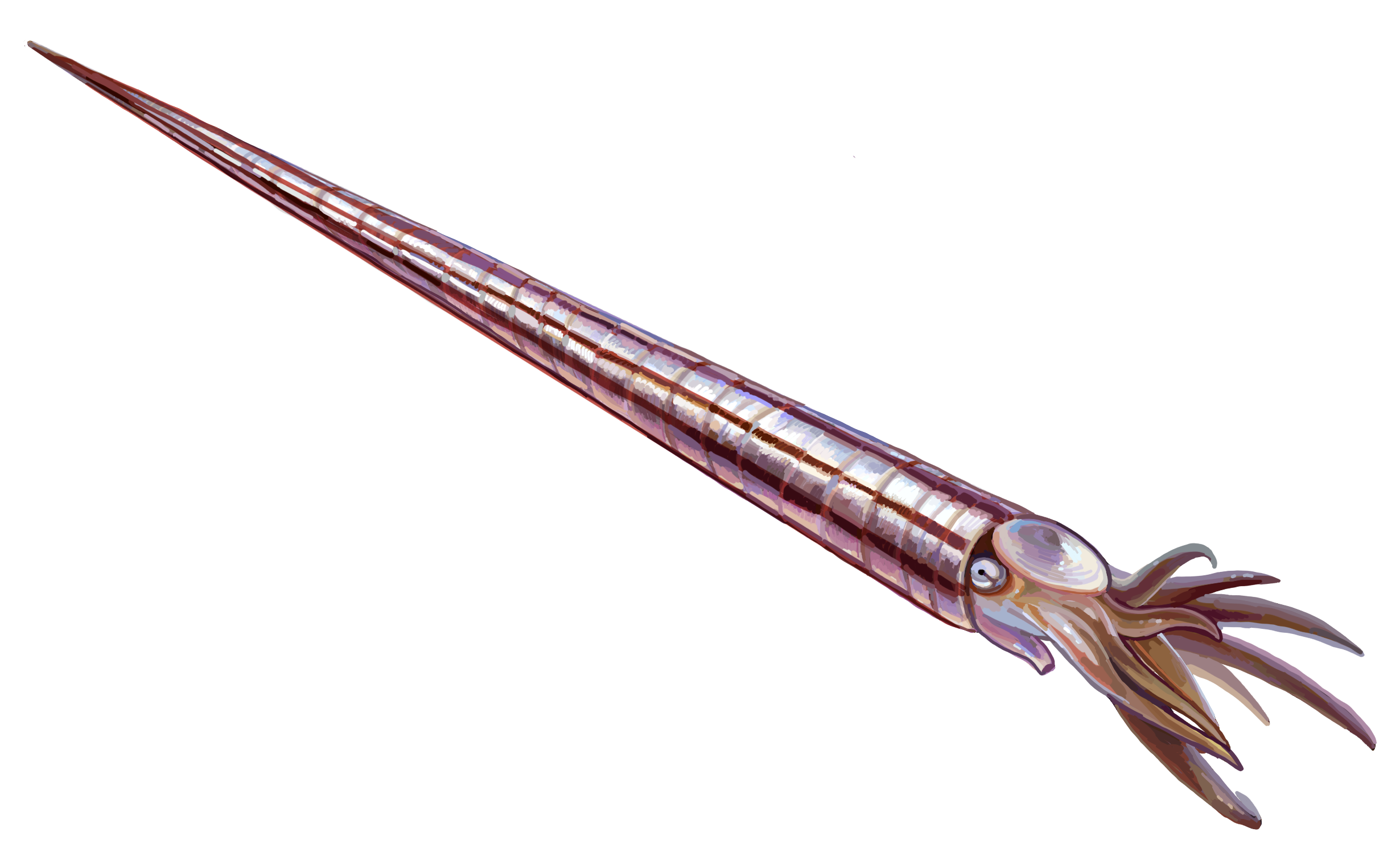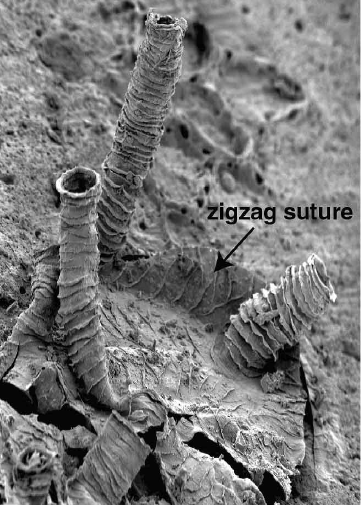|
Upper Ordovician
The Late Ordovician is the third and final epoch of the Ordovician period, lasting million years and spanning from around 458.2 to 443.1 million years ago. The rocks associated with this epoch are referred to as the Upper Ordovician Series. At this time, Western and Central Europe and North America collided to form Laurentia, while glaciers built up in Gondwana, which was positioned over the South Pole. This caused a drop in global temperatures, resulting in "ice house" conditions. For most of this time, life continued to flourish, but at and near the end of the period, there were mass-extinction events that seriously affected planktonic forms like conodonts, graptolites, and some groups of trilobites (Agnostida and Pytchopariida, which completely died out, and the Asaphida which were much reduced). Brachiopods, bryozoans and echinoderms were also heavily affected, and the endocerid cephalopods died out completely, except for possible rare Silurian The Silurian ( ) is a ... [...More Info...] [...Related Items...] OR: [Wikipedia] [Google] [Baidu] |
International Commission On Stratigraphy
The International Commission on Stratigraphy (ICS), sometimes unofficially referred to as the International Stratigraphic Commission, is a daughter or major subcommittee grade scientific organization that concerns itself with stratigraphy, stratigraphical, geology, geological, and chronology, geochronological matters, worldwide. It is the largest subordinate body of the International Union of Geological Sciences (IUGS). The ICS is essentially a permanent working committee, working subcommittee, which meets far more regularly than the quadrennial meetings scheduled by the IUGS, when it meets as a congress or committee, membership of the whole. Aims One of its main aims, a project begun in 1974, is to establish a multidisciplinary standard and global geologic time scale that will ease paleontology, paleontological and geobiology, geobiological comparisons region to region by benchmarks with stringent and rigorous strata criteria called Global Boundary Stratotype Section and Points ... [...More Info...] [...Related Items...] OR: [Wikipedia] [Google] [Baidu] |
Trilobite
Trilobites (; meaning "three-lobed entities") are extinction, extinct marine arthropods that form the class (biology), class Trilobita. One of the earliest groups of arthropods to appear in the fossil record, trilobites were among the most successful of all early animals, existing in oceans for almost 270million years, with over 22,000 species having been described. Because trilobites had wide diversity and an easily fossilized mineralised exoskeleton made of calcite, they left an extensive fossil record. The study of their fossils has facilitated important contributions to biostratigraphy, paleontology, evolution, evolutionary biology, and plate tectonics. Trilobites are placed within the clade Artiopoda, which includes many organisms that are morphologically similar to trilobites, but are largely unmineralised. The relationship of Artiopoda to other arthropods is uncertain. Trilobites evolved into many ecological niches; some moved over the seabed as predators, scavengers, or ... [...More Info...] [...Related Items...] OR: [Wikipedia] [Google] [Baidu] |
Silurian
The Silurian ( ) is a geologic period and system spanning 23.5 million years from the end of the Ordovician Period, at million years ago ( Mya), to the beginning of the Devonian Period, Mya. The Silurian is the third and shortest period of the Paleozoic Era, and the third of twelve periods of the Phanerozoic Eon. As with other geologic periods, the rock beds that define the period's start and end are well identified, but the exact dates are uncertain by a few million years. The base of the Silurian is set at a series of major Ordovician–Silurian extinction events when up to 60% of marine genera were wiped out. One important event in this period was the initial establishment of terrestrial life in what is known as the Silurian-Devonian Terrestrial Revolution: vascular plants emerged from more primitive land plants, dikaryan fungi started expanding and diversifying along with glomeromycotan fungi, and three groups of arthropods ( myriapods, arachnids and hexapods) ... [...More Info...] [...Related Items...] OR: [Wikipedia] [Google] [Baidu] |
Cephalopod
A cephalopod is any member of the molluscan Taxonomic rank, class Cephalopoda (Greek language, Greek plural , ; "head-feet") such as a squid, octopus, cuttlefish, or nautilus. These exclusively marine animals are characterized by bilateral symmetry, bilateral body symmetry, a prominent head, and a set of cephalopod arm, arms or tentacles (muscular hydrostats) modified from the primitive molluscan foot. Fishers sometimes call cephalopods "inkfish", referring to their common ability to squirt Cephalopod ink, ink. The study of cephalopods is a branch of malacology known as teuthology. Cephalopods became dominant during the Ordovician period, represented by primitive nautiloids. The class now contains two, only distantly related, Extant taxon, extant subclasses: Coleoidea, which includes octopuses, squid, and cuttlefish; and Nautiloidea, represented by ''Nautilus (genus), Nautilus'' and ''Allonautilus''. In the Coleoidea, the molluscan shell has been internalized or is absent, where ... [...More Info...] [...Related Items...] OR: [Wikipedia] [Google] [Baidu] |
Endocerid
Endocerida, from Ancient Greek ἔνδον (''éndon''), meaning "inside", and κέρας (''kéras''), meaning "horn", is an extinct nautiloid order, a group of cephalopods from the Lower Paleozoic with cone-like deposits in their siphuncle. Endocerida was a diverse group of cephalopods that lived from the Early Ordovician possibly to the Late Silurian. Their shells were variable in form. Some were straight ( orthoconic), others curved (cyrtoconic); some were long (longiconic), others short (breviconic). Some long-shelled forms like '' Endoceras'' attained shell lengths close to . The related '' Cameroceras'' is anecdotally reported to have reached lengths approaching , but these claims are problematic. The overwhelming majority of endocerids and nautiloids in general are much smaller, usually less than a meter long when fully grown. Morphology Endocerids had a relatively small body chamber as well as a proportionally large siphuncle, which in some genera reached nearly half ... [...More Info...] [...Related Items...] OR: [Wikipedia] [Google] [Baidu] |
Echinoderm
An echinoderm () is any animal of the phylum Echinodermata (), which includes starfish, brittle stars, sea urchins, sand dollars and sea cucumbers, as well as the sessile sea lilies or "stone lilies". While bilaterally symmetrical as larvae, as adults echinoderms are recognisable by their usually five-pointed radial symmetry (pentamerous symmetry), and are found on the sea bed at every ocean depth from the intertidal zone to the abyssal zone. The phylum contains about 7,600 living species, making it the second-largest group of deuterostomes after the chordates, as well as the largest marine-only phylum. The first definitive echinoderms appeared near the start of the Cambrian. Echinoderms are important both ecologically and geologically. Ecologically, there are few other groupings so abundant in the deep sea, as well as shallower oceans. Most echinoderms are able to reproduce asexually and regenerate tissue, organs and limbs; in some cases, they can undergo ... [...More Info...] [...Related Items...] OR: [Wikipedia] [Google] [Baidu] |
Bryozoa
Bryozoa (also known as the Polyzoa, Ectoprocta or commonly as moss animals) are a phylum of simple, aquatic animal, aquatic invertebrate animals, nearly all living in sedentary Colony (biology), colonies. Typically about long, they have a special feeding structure called a lophophore, a "crown" of tentacles used for filter feeder, filter feeding. Most Marine (ocean), marine bryozoans live in tropical waters, but a few are found in oceanic trenches and polar waters. The bryozoans are classified as the Stenolaemata, marine bryozoans (Stenolaemata), Phylactolaemata, freshwater bryozoans (Phylactolaemata), and Gymnolaemata, mostly-marine bryozoans (Gymnolaemata), a few members of which prefer brackish water. 5,869living species are known. Originally all of the crown group Bryozoa were colonial, but as an adaptation to a mesopsammal (interstitial spaces in marine sand) life or to deep-sea habitats, secondarily solitary forms have since evolved. Solitary species have been described i ... [...More Info...] [...Related Items...] OR: [Wikipedia] [Google] [Baidu] |
Brachiopod
Brachiopods (), phylum (biology), phylum Brachiopoda, are a phylum of animals that have hard "valves" (shells) on the upper and lower surfaces, unlike the left and right arrangement in bivalve molluscs. Brachiopod valves are hinged at the rear end, while the front can be opened for feeding or closed for protection. Two major categories are traditionally recognized, articulate and inarticulate brachiopods. The word "articulate" is used to describe the tooth-and-groove structures of the valve-hinge which is present in the articulate group, and absent from the inarticulate group. This is the leading diagnostic skeletal feature, by which the two main groups can be readily distinguished as fossils. Articulate brachiopods have toothed hinges and simple, vertically oriented opening and closing muscles. Conversely, inarticulate brachiopods have weak, untoothed hinges and a more complex system of vertical and oblique (diagonal) muscles used to keep the two valves aligned. In many brachio ... [...More Info...] [...Related Items...] OR: [Wikipedia] [Google] [Baidu] |
Asaphida
Asaphida is a large, morphologically diverse order of trilobites found in marine strata dated from the Middle Cambrian until their extinction during the Silurian. Asaphida contains six superfamilies (Anomocaroidea, Asaphoidea, Cyclopygoidea, Dikelocephaloidea, Remopleuridoidea and Trinucleioidea), but no suborders. Asaphids comprise some 20% of described fossil trilobites. In 2020, the superfamily Trinucleioidea was proposed to be raised to an order ( Trinucleida) and removed from Asaphida. Morphology The Asaphids generally have cephalon (head) and pygidium (tail) parts similar in size, and most species have a prominent median ventral suture. Heads are often flat, and carapace furrows in the head area are often faint or not visible. Thoracic segments typically number 5 - 12, though some species have as few as two and some as many as 30. They also generally have a wide doublure, or rim, that surrounds the cephalon. This causes some specimens to be described as having a chara ... [...More Info...] [...Related Items...] OR: [Wikipedia] [Google] [Baidu] |
Agnostida
Agnostida are an order of extinct arthropods which have classically been seen as a group of highly modified trilobites, though some recent research has doubted this placement. Regardless, they appear to be close relatives as part of the Artiopoda. They are present in the Lower Cambrian fossil record along with trilobites from the Redlichiida, Corynexochida, and Ptychopariida orders, and were highly diverse throughout the Cambrian. Agnostidan diversity severely declined during the Cambrian-Ordovician transition, and the last agnostidans went extinct in the Late Ordovician. Systematics The Agnostida are divided into two suborders — Agnostina and Eodiscina — which are then subdivided into a number of families. As a group, agnostids are isopygous, meaning their pygidium is similar in size and shape to their cephalon. Most agnostid species were eyeless. The systematic position of the order Agnostida within the class Trilobita remains uncertain, and there has been c ... [...More Info...] [...Related Items...] OR: [Wikipedia] [Google] [Baidu] |
Graptolite
Graptolites are a group of colonial animals, members of the subclass Graptolithina within the class Pterobranchia. These filter-feeding organisms are known chiefly from fossils found from the Middle Cambrian ( Miaolingian, Wuliuan) through the Lower Carboniferous ( Mississippian). A possible early graptolite, ''Chaunograptus'', is known from the Middle Cambrian. Recent analyses have favored the idea that the living pterobranch '' Rhabdopleura'' represents an extant graptolite which diverged from the rest of the group in the Cambrian. Fossil graptolites and ''Rhabdopleura'' share a colony structure of interconnected zooids housed in organic tubes (theca) which have a basic structure of stacked half-rings (fuselli). Most extinct graptolites belong to two major orders: the bush-like sessile Dendroidea and the planktonic, free-floating Graptoloidea. These orders most likely evolved from encrusting pterobranchs similar to ''Rhabdopleura''. Due to their widespread abundance, pl ... [...More Info...] [...Related Items...] OR: [Wikipedia] [Google] [Baidu] |







